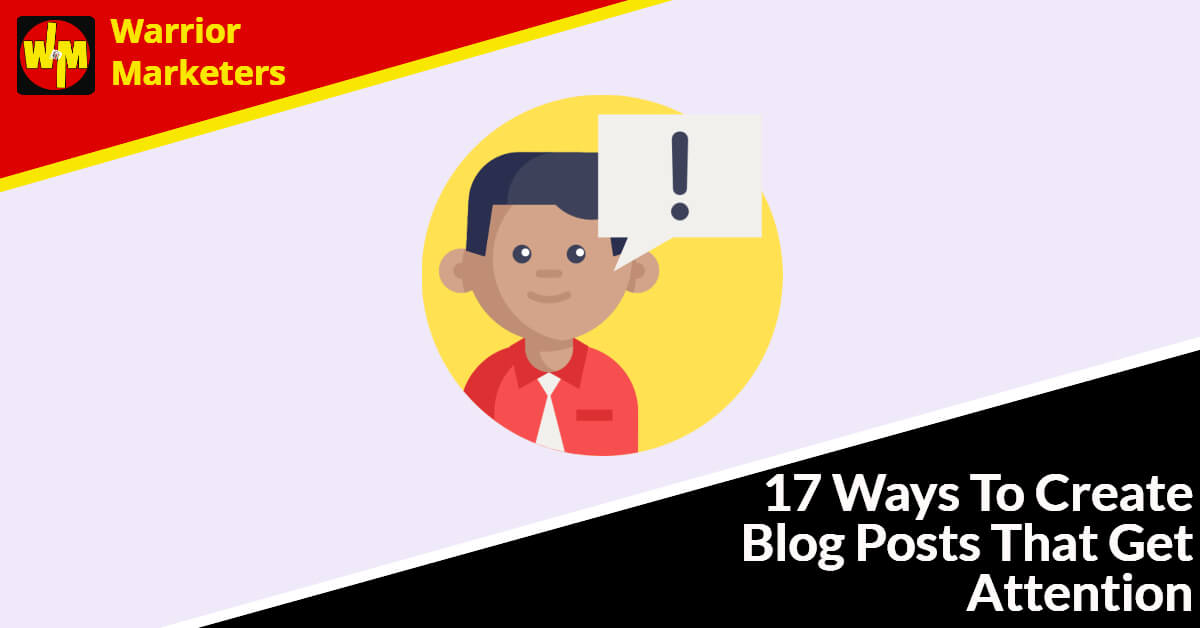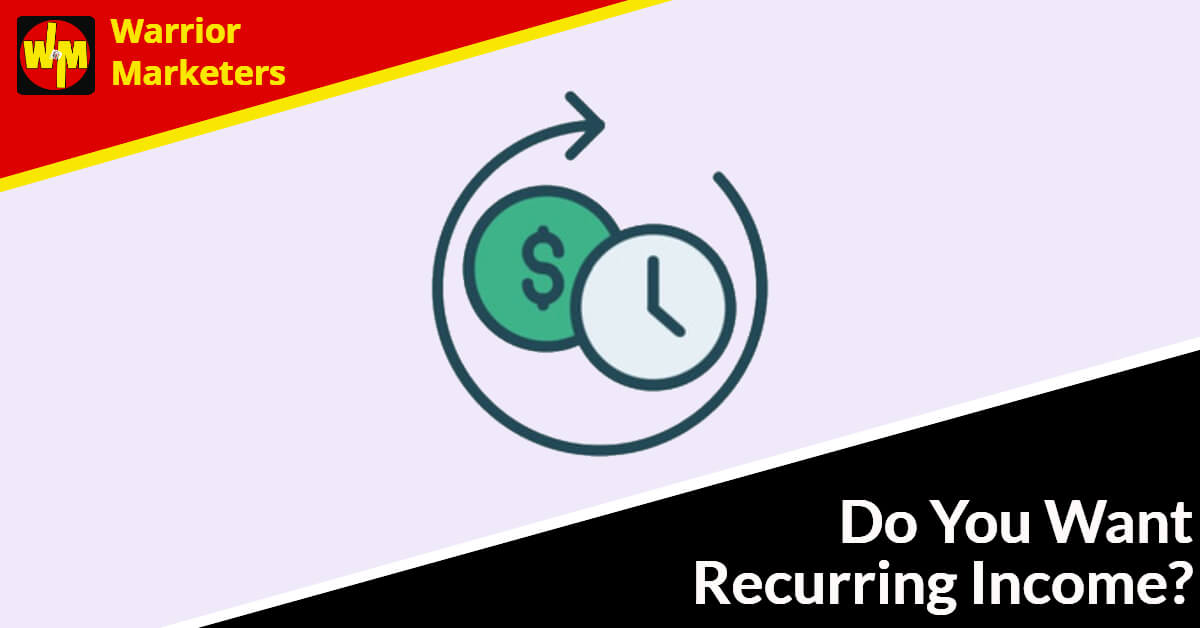Tutorial
17 Ways To Create Blog Posts That Get Attention
17 Ways To Create Blog Posts That Get Attention

You can put a lot of content up on your blog, but your blog isn’t going to be successful if no one is reading the content.
That’s why one of the biggest keys to your success is to create engaging content that attracts readers and keeps them coming back to your blog again and again.
Here’s how to do it…
1. Give Your Audience What They Want

The first thing you need to do is understand what your audience wants. In other words, what sort of content are they already consuming? Here’s how to figure this out:
- Find out what sort of infoproducts they’re buying. Check bestsellers on marketplaces such as Amazon.com, Udemy.com. ClickBank.com and JVZoo.com.
- See what topics get a lot of traction on social media.
- Check question and answer sites to see what’s popular, including Quora.com, Yahoo! Answers, and JustAnswer.com.
- Browse niche groups (on Facebook) and forums to see what topics keep popping up again and again.
- Read your competitors’ blogs to see which topics get a lot of discussion and social media shares.
- Ask your audience what they’d like to learn more about.Check your own blog to see what topics you’ve posted about in the past that have generated a lot of interest.
Next…
2. Write For Your Audience

In order to write for your audience, you need to understand exactly who they are. You’ll need to do some research to uncover their demographics, and then spend some time reading niche discussions and talking to your audience to learn more about them.
Here’s what you want to know:
- Age
- Gender
- Where they live.
- Marital status.
- Kids or not.
- Rent or own.
- Income level.
- Education level.
- Biggest niche challenges/obstacles/pain points.
- Solutions they’ve tried.
- Why those solutions haven’t worked.
- What they want.
- What motivates them.
- Where they get their niche information.
- Their niche level (beginner, intermediate, expert).
Next…
3. Catch Attention With Titles

Engagement starts with your blog titles, which is why you need to invest time creating benefit-driven titles with a little razzle dazzle to catch attention.
For example, “How to Lose Weight” shares a benefit. It’s descriptive, but it’s also a little boring.
In order to catch attention, you need to add a little razzle dazzle. E.G., “The Weird Weight Loss Trick That Shook Hollywood (Psst, It Will Work for You Too!)”
Next…
4. Open With A Bang

You need to capture attention right away, which is why your opener should work hard to get and keep your audience’s attention. You can do this by:
- Building anticipation by adding a “key points” section in your opener.
- Telling a story right away.
- Providing a startling fact or statistic.
- Busting a myth, or sharing other unexpected information.
- Sharing a really good tip right away to build interest.
- Posting an interesting quote (from a famous person).
- Showing that you understand the reader and their problem, such as by empathizing with the reader.
Next…
5. Create “You”-Centered Content

Your content needs to be all about your readers, specifically with regards to their problems and how to solve them. Unfortunately, some bloggers tend to make their content more about themselves, such as how they discovered a particular tip or trick.
Here’s a quick way to check if you’re focused on your readers: see how many times you use words like “you” and “your,” versus words centered on yourself (such as I, me, and mine). Rewrite author-oriented content to make it more about the reader.
For example, “I’ll share my favorite weight-loss trick” is author-oriented. You can rewrite it to change the focus like this: “You’ll discover a proven weight-loss trick.”
6. Avoid Passive Language

Passive language is where you craft sentences so that the subject receives an action, rather than the subject performing an action. Readers tend to find it tedious and boring to read this sort of content.
Here’s an example of a passive sentence: The dog must be walked five times per day.
You’d rewrite it to make it active, like this: You must walk the dog five times per day.
7. Engage Readers With Stories

One really good way to engage readers on an emotional level is to draw them in with a story.
For example, you can write a story about how you or someone else in the niche overcame the same problem as your readers.
Another example: You might share a heartwarming story, or even a story about an embarrassing moment. These stories build rapport.
Still one more example: if you’re trying to share a lesson, share it in the form of a story. It makes it both more engaging and memorable.
8. Ask Questions To Engage Readers

You can ask questions in the beginning, middle or end of your content to engage readers and encourage them to interact. For example:
- Have you ever _______?
- Do you ever feel ________?
- How would you feel?
- What is your favorite tip?
- What is the hardest part of _______?
- What do you think?
- What would you do?
Next…
9. Build Anticipation And Curiosity

Starting in the beginning and sprinkled throughout your content, you’ll want to build anticipation and curiosity for what’s coming.
For example: “In just a moment, you’ll discover the #1 way to get 1000 visitors in the next 24 hours. But first…”
E.G., “Tomorrow you’ll find out which food you should NEVER eat if you want to lose weight – and chances are, you’ve already eaten it this week!”
10. Make Your Audience Smile

If you can make your audience feel something (especially a positive emotion), you’re going to have their full attention. One way to do this is to inject some humor (sparingly) into your content to make your audience smile and chuckle.
Before you start cracking jokes in your content, be sure that you’ve researched your audience, and you understand them.
What people find humorous is subjective, and it also differs across cultures. Indeed, what you find funny may be outright offensive to others, so keep your humor G-related and appropriate.
11. Serve Up Unique Content

One really good way to keep readers engaged is to give them content they’ve never seen before. Elsewhere in these guides, we’ve talked about how to create unique content, such as by sharing unique case studies, stories, and even creating formulas to teach step-by-step content.
Here’s another idea: use fresh comparisons to explain concepts and even step-by-step processes.
Let’s suppose you’re writing about customer retention. Most of your competitors are going to list and explain all the components of creating satisfied customers. You can make your content unique by comparing customer retention to the Hollywood red-carpet VIP treatment. It’s a simple thing, but it makes your content more interesting, and it stands out from other similar content.
12. Be Concise

If you want to keep readers engaged, then cut out all the fluff and filler. If a page, a paragraph, or even a sentence isn’t necessary to getting your point across, then delete it. You want to keep your content concise and “meaty,” which will keep readers engaged.
One good way to keep your content focused is to create an outline before you write. The key here is to make this outline as detailed as possible.
Not only should you list the major steps and points you want to cover, but you can also list substeps, tips, examples and so on. Then once you start writing, stick to your outline, and delete anything that veers from this outline.
13. Use A Friendly Tone

If you remember reading a few textbooks during your school days, you might also remember some pretty yawn-inducing passages. The problem? These textbook writers shared information, but they didn’t seem all that interested in connecting with readers. While their writing may be technically correct, it’s boring.
Naturally, you’ll want to avoid this sort of stilted, textbook-style writing.
One way to connect with your readers is to write with a friendly, conversational tone.
Think of how you’d write to a friend, and share your content in a similar manner. (This guide is an example of writing with a friendly tone – note how this content isn’t speaking above anyone, it’s not pretentious, and it doesn’t try to impress with big words and complex sentence structure.)
14. Offer Quick Wins

A quick win is a tip or other bit of information that someone can apply fairly quickly, and then get fairly quick results too. Your readers should be able to instantly recognize the value of the information and how quickly they’ll get good results if they apply it.
For example, if you’re sharing information to beginning marketers about how to find a niche, you might teach them to use a keyword tool to find niches they never knew existed (e.g., enter partial searches such as “how to ____” and “get rid of” and “secrets of”).
Quick wins keep your readers engaged on the current blog post they’re reading, as they’ll be eagerly searching for other gold nuggets of information. However, making a habit of providing quick wins in your posts also keeps readers engaged with your blog as a whole and coming back for more.
15. Insert Awesome Visuals

Another way to engage readers is by inserting useful, polished graphics. This includes:
- Infographics.
- Tables.
- Charts.
- Illustrations.
- Screenshots.
- Photos.
- GIFs.
And similar images.
For example, you might include an infographic to make data-heavy information easier to understand.
Another example: you might include a photo or illustration that shows someone how to do something (such as the proper way to stand when doing a weight-lifting exercise such as a squat).
Point is, a good visual can attract the eye and draw the reader back into the text, and it can also add a lot of value to the content. Either way, good visuals engage readers!
16. Share Tips And Examples

Another way to add value while engaging readers is to generously provide plenty of tips and examples in your content.
As an example, take a look at #15 above. The instruction was to provide visuals in your blog posts.
You then got a list of seven examples of different types of visuals you can create, along with specific examples of some of those seven types.
17. Format For Easy Readability

If people come to your blog and see a wall of text, they’re going to hit the back button without even bothering to begin reading your content. That’s why you need to format your content for easy readability, which is a crucial key to engaging readers.
Check out these tips:
- Break up long list paragraphs by using bulleted lists instead (like this one).
- Use short sentences and short paragraphs.
- Insert graphics to help break up long passages of text.
- Utilize headings and subheadings to provide white space and highlight important information.
You should also ensure your blog uses a responsive theme with a column layout. This ensures that when people read your articles on a mobile device, the article text takes up the entire screen (that’s desirable on small screens).
The content should cover part of the screen, and the sidebar should cover the remaining part. Again, use a responsive theme, which will resize your columns for easy readability, depending on the device.
Now a few parting thoughts…
Conclusion

The people with the biggest, most popular and most profitable blogs are also the folks who know how to craft engaging content.
If you’re looking to find that sort of success with your blog, then I highly recommend you putting these 17 keys for crafting engaging content to work for you.
If you really want to know more about the power of blogging, you can take a look at the Rapid Blogging Blueprint training course or if you just want a few pointers for now you can grab the featured resource below for a free blogging report; download, read it and take action 🙂

7 Tips To Succeed In Affiliate Marketing
7 Tips To Succeed In Affiliate Marketing

Anyone can find success in affiliate marketing but not every person who joins such a program succeeds.
These are some of the tips that can help beginners become successful affiliates and make some good income from such ventures.
1. Carve Out A Niche
This is a very critical factor in affiliate marketing. It is important that you identify a specific market or segment that you want to work in and then focus on that.
The internet has so many users and the competition for attention is always stiff.
2. Carefully Select Your Merchants
It is important to carry out thorough research before agreeing to work with a specific merchant. This is because those who sell consumers inferior products risk losing future business opportunities.
You should also work with merchants who are reputable and actually pay commissions on time. Can you imagine constantly following up with a company to remit your dues even after you’ve brought it business? It’s utterly frustrating and demoralizes the affiliates.
Work with a brand that holds up its end of the deal without additional pressure.
3. Use Captivating Content
When promoting products on your website, customers first get to interact with other content before being directed to a link and ultimately the merchant’s website.
First impressions are everything and if you don’t get them right then your marketing attempts will always flop.
4. Keep Track Of Results
Do not just push for sales without analyzing your performance. Tracking your results includes monitoring feedback from consumers and checking the amount of sales made on a monthly basis.
You can’t keep on selling a product that people just don’t want to buy.
5. Dedication
Affiliate programs are great avenues for making money but success does not come easy for a publisher.
The problem with most beginners is that they want to make quick money but are not willing to put in work.
6. Sell Products That You Believe In
It is very easy to sell a product that you’ve actually used yourself or believe in.
Don’t be tempted to recommend a product just to get an affiliate commission because if the product is poor, your buyers won’t forget that you recommended it to them.
7. Update Your Site
To increase the visibility of your site by getting high rankings on search engines, you must constantly update the contents using target key words and relevant information. That will then help drive traffic to it.
You can create content yourself, outsource it or curate content from other sources (always attribute the source with a ink to the original).
How Can You Find Affiliate Programs?

I think one of the most fundamental questions that most people interested in becoming affiliates ask is about where to find products to promote.
There are several affiliate programs available but it’s always advisable to choose what would best work for you. That increases the possibility of becoming successful in the venture because it reduces the strain caused by pushing brands that you are not comfortable with.
These are some of the best ways to find a suitable affiliate program for beginners and even for those who are already considered veterans in the sector.
Well Established Affiliate Networks
This would be the most ideal place to start because such networks are usually well organized and trusted.
Some of these networks include but not limited to:
- Linkshare
- Commission Junction
- Shareasale
- Pepperjam Network
- Google affiliate networks
- JVzoo
- Warriorplus
Such networks are great because they have a well-established working relationship with the big companies that pay good money. It’s a safe place for a beginner to start his or her affiliate marketing career.
They charge the merchants commissions for linking them up with affiliates which means that your pay as a publisher will be relatively reduced to carter for their commission payment.
Familiar Product
You can always start by promoting a brand that you use yourself or are well aware of. It’s always easy to sell what you already believe in as opposed to just trying to convince customers to buy a product that you’ve never even used before.
You can check the sites of your favorite brands and see if they have affiliate programs.
It’s a safe bet and somehow a familiar ground even for beginners.
Independent Affiliate Programs
These are programs that are run by the merchants themselves using affiliate software to take care of the technical aspects of the system.
The advantage of independent affiliate networks is that the pay is much better since they don’t use middlemen. However if the program is not properly managed it can be a disaster due to lack of creativity and delayed payments.
They are still the best though especially if you find one that is well managed and pays attention to the needs of the publishers. They are not easy to find but you can use keywords on search engines to find them.
E-Product Networks
These promote products that are downloaded rather than shipped like e-books and other programs.
Some of these networks include Clickbank, e-junkie and Avangate.
These are some of the ways in which you can find and join an affiliate program. They are not exhaustive, but they are among some of the best options.
I hope these affiliate marketing tips have helped, and if you want to know more about affiliate marketing check out the featured resource below for a free report; download, read it and take action 😊

3 Powerful Recurring Income Strategies
3 Powerful Recurring Income Strategies

With a recurring revenue business model, you’ll be able to generate a steady and reliable income every single month. Best of all, you don’t have to stick with just one format and can expand your network as you discover new demands for content.
The key is to always look forward ways to tie a product or service into a recurring revenue source.
You always want to incorporate your funnel into a recurring income source whenever possible.
In a previous article we looked at recurring revenue streams and membership platforms
In this article, let’s look at software, physical product subscriptions and online courses.
So, let’s get cracking…
Software Products (SaaS)

SaaS stands for Software as a Service and is offered on a subscription basis.
The benefits are quite obvious to customers: in exchange for their recurring payments, they are given the ability to use the software while knowing that it is updated regularly and that they’ll gain access to prompt customer support.
From Drop Box and Adobe to mailing list providers like MailChimp and Aweber, many of the leading brands have incorporated SaaS into their businesses and for good reason: Doing so drastically increases their yearly income, while making it easier for them to provide value to their customer base.
For example, perhaps you run a community focused on teaching people how to build a successful blow. You could create a training program that teaches them how to launch a successful website, while promoting the tools they need to get the job done.
This might include SaaS based mailing lists, hosting for their blog, or perhaps design and graphic tools, as well as plugins. The possibilities are endless when it comes to making money promoting a variety of recurring revenue products.
There are dozens of important tools you can easily promote within your own content to generate revenue.
And for every new customer you send their way, you’ll earn a recurring income from their ongoing payments. Win-win!
Physical Product Subscriptions

You’ve likely heard of the Dollar Shave Club as well as other subscription boxes that focus on health, fitness or cosmetics, just to name a few. These are growing in popularity every single day.
Here’s how it works:
Customers subscribe to a service and in exchange they receive a box or products every month. The products vary but are usually all in the same niche or industry.
This format works well because recipients not only look forward to receiving new products every month in the mail, but they become part of a community of active users.
The downside is that creating a physical product subscription program isn’t always the easiest business to launch as it will require coming up with products and packaging as well as shipping and distribution partners, but don’t overlook the possibilities. There may be a way to simplify the program so that it works for your business.
For example, an author who self-publishes books via Amazon KDP could create a subscription program where readers can sign on to receive a new book every month via their exclusive book club.
While an author may not release a new book every month, they could easily send out some of their favorite reads, promoting other up-and-coming authors. The shipping costs would be minimal and it could even be automated through sites like Lulu.com.
How could you incorporate a physical product subscription into your business?
It’s time to put that thinking cap on and see how you could take advantage of this profitable opportunity!
Tip: You could also combine a membership program with a physical product subscription plan.
For example, you could sell access to an online training program that offers guides, tutorials and videos and provide them with a physical copy of the course via a book.
Online Courses

While courses don’t usually bring in recurring income on their own since many are designed on a platform that involves a student paying a one-time fee for access to the training, you can still generate consistent recurring revenue by focusing on a strong front-end sales funnel that directs students to other products and services.
For example, while your course may be a one-time charge, you could give students the option to upgrade to a monthly membership that offers tools and resources associated to the topic of the training program.
This could include additional auxiliary components such as webinars, printable downloads or additional workbooks that go beyond the scope of your course.
Start by thinking about a topic for your course, as well as the content formats you would feel comfortable creating.
This could include:
- Text-based lesson plans
- Video Tutorials
- Webinars
- Interviews with Experts
- Workbooks and Customized Lesson Plans
- Printables (checklists, guides, etc.)
The key is to identify an ongoing demand for help with specific problems. Your course should always focus on one main niche so you’re able to create content that is in-demand, relevant and focused.
At the same time, you don’t want to box yourself into a corner. The topic you choose should be something you can see yourself still interested in a year from now.
By purchasing access to your course, they are given the knowledge needed to accomplish specific goals.
Most of the top-selling courses focus on one main subject and then they expand their program by allowing students to either purchase additional access to upgrades or by offering additional resources after someone has graduated from the course.
Don’t let anything stand in your way! Even if you aren’t an expert on the topic, chances are you still have something worthy of teaching and that people will pay money for.
Keep in mind that for your membership program to be successful, you need to come up with a strong hook.
A hook reels you in. It sets your program apart. It works at differentiating your program from your competitors and tells potential subscribers why they benefit from signing up for your program. It’s visceral and compelling.
Evaluate your membership program’s strengths and unique benefits.
- How does it stand out?
- What is the greatest asset you offer members?
- How is it different?
- What will someone learn or improve by being a part of it?
Your task of the day:
Step 1: Identify an ongoing problem in your niche where people are actively seeking guidance, training and ultimately, a solution.
Step 2: Create a list of topics that you should cover in your course based on those common questions. Then, decide on the various formats you plan to use (video, printables, workbooks, etc.).
Step 3: Next, go through that list and narrow your focus so that you are targeting a specific segment of your market.
Need help identifying a problem in your niche or coming up with a topic for your course?
Here are a few ways to uncover possibilities:
Send an email out to your mailing list that asks what your readers need help with. You can either set the email so they reply with their own feedback, or choose 3-4 topics and create a survey that asks them to choose only one.
Search Reddit sub-threads as well as Q&A sites like Quora for popular questions and ongoing discussions. You want your course to be based on an evergreen, common problem in your market.
Search platforms like Udemy.com and Teachable.com to see what courses are selling and what kind of training is being offered.
Sites like Teachable will show you a breakdown of all lesson plans so you can get a feel for the scope of the training and identify what could be missing. Then, include coverage in your own course to stand out in your market.
Tip: Creating a training program is easy with sites like https://www.Teachable.com because you aren’t required to build your own website or learn HTML.
All you have to do is enter in your content or link to your videos and Teachable will compile your course so that people can move through it at their own pace while keeping track of their progress.
If you want to know more about creating a profitable online course, check out the featured resource below for a free report; download, read it and take action 😊

Do You Want Recurring Income?
Do You Want Recurring Income?

If you’re looking to boost your income, grow a loyal following and position your brand as the go-to source in your market, there is no easier way than by injecting a recurring revenue stream into your business. Trying to build a continuity program into your business is a must.
With recurring revenue, you can create a strong foundation for your business while taking advantage of the opportunity to incorporate additional income streams into an ever-growing community.
Plus, recurring revenue is consistent and predictable. Unlike other income streams, such as with one-off products or services, with a monthly or yearly recurring revenue platform you know what to expect. You aren’t bouncing from one product launch to another.
Instead, you can focus on growing your community and extending the value of your program. Instead, you are focused on a scalable business and stop trading your time for money.
This article will show you exactly how to join the recurring revenue revolution and how it can work in almost any niche or market.
You’ll also discover how to choose a format that focuses on long-term success so you can enjoy the benefits of passive income every month – all on complete autopilot.
And that’s just one of the many advantages of incorporating a stream of recurring income into your business.
Plus, it’s always easier to sell to existing customers than it is to convert new ones.
Are you ready to begin? Let’s get started!
Recurring Revenue Streams

You’ve seen the rise of recurring revenue streams in your everyday life. Blockbuster fell victim to Netflix; cable TV fell victim to online streaming services like Amazon Prime.
Everywhere you turn, companies are focused on building multi-million dollar businesses on the recurring income platform.
In fact, virtually every business can benefit from adding a recurring revenue stream.
There’s no doubt about it; now is the time to get in on the action.
To start, it’s important to come up with a primary benefit for your recurring income stream.
- Why would people want to sign up for your program?
- What are the benefits?
- How is it different from others?
For example, with a spa package, someone could purchase a $100 package that gives them the ability to book 3 massage treatments, rather than the usual 2.
With an online business, you could offer access to advanced training or exclusive resources not available anywhere else.
The key is to highlight the benefits upfront. Customers sign on for recurring programs because they are getting more bank for their buck, or they are being given access to something unique, special and exclusive.
Or perhaps they are looking to save time or alleviate an otherwise steep learning curve.
Regardless of the format you choose, you need to come up with a clear benefit that will persuade people to sign on and stay subscribed.
Membership Programs

Subscription-based programs are not only extremely profitable, as they generate recurring income, but they are single-handedly one of the easiest ways to gain traction in your market, and position yourself as an expert in your field.
You’ve likely seen this in action for yourself when you’ve signed up for a course or training program. The course instructor has positioned themselves as an expert on the topic simply by providing a clear, workable system to accomplishing a specific goal or task.
By providing step-by-step training in a specific niche, you will be able to secure your foothold in your market and become a leading source for quality information.
In other words, you become the go-to person in your field. They are phenomenal at increasing your customer outreach, maximizing exposure and managing a sales funnel so that you can leverage your ever-growing community.
Another great thing about the membership model is that you can create a flagship program that is geared towards helping your subscribers learn about one topic, and then work towards expanding your program as your community grows so that you are keeping subscribers moving through your sales funnel.
There are many ways to build a successful membership program. Begin by considering the commonly asked questions in your niche. Perhaps someone needs help with graphic design. Rather than spending all your time teaching people how to master a specific software program on a one-on-one basis, you could create a membership site that offers access to video training that shows them how to use a third-party product to enhance their business.
Then, not only are you generating recurring income from your own training program, but you are also able to make money via affiliate marketing.
There are a few popular models used to create membership websites, including:
Evergreen Content Model
This is where your content is released in the same sequence regardless of when someone joins your program.
For example, someone who joins in January would receive access to the first month’s content immediately, and then in February they would receive access to the second month’s content and so on.
A member who joins in February would still receive January’s content as month 1. Every member starts at the beginning of your content cycle and then progresses as the month’s go on.
With an evergreen content system, the content is released sequentially based on each customer’s join date.
The only downside to this format is that you may struggle to offer group coaching as students will be at different stages of your training.
Current Month Access
This type of membership platform is based on the current month. Someone signing up in January would receive access to that current month’s content.
If someone signed on in February, they would only gain access to that current month’s content. So, every member is given access only to the latest update.
You can further monetize this style of membership site by giving members the option to purchase access to archived content separately.
This model helps to increase the value of every customer because they are purchasing access to current content while being able to purchase additional access to unlock prior months or advanced content. This format works well if your content is segmented so that each month’s content can stand alone and isn’t dependent on previous lessons or training.
All Access Pass (Content Buffet)
This format usually involves providing members with access to all previous content as well as new content on a monthly basis as long as they are a paid member.
Typically, you can price these membership programs at a higher price point because subscribers are gaining access to all the available content, regardless of when it was released.
Programs that run this way would include programs like https://www.Lynda.com where you pay for access to their training database and can then browse through their full library of courses and training material that continues to grow.
Consider the different formats available so you can determine what would work best for your target market.
For example, the weight loss market is a popular one for membership programs (example: Weight Watchers), because their monthly program guides someone through their journey from the very beginning until they’ve reached their weight loss goals.
Their monthly membership never ends either because even when someone finally reaches their goal weight, they are then transferred into a membership program designed to help them maintain their weight.
And another valuable part of their community is in the groups and forums members gain access to. In these areas, they can find an accountability partner, personal online trainers and coaches that help them stay on track.
With this type of platform, you are not only able to generate income monthly from the recurring membership fees, but you could easily expand your membership program to offer additional upgrades, such as access to weekly meal plans, community support, fitness strategies and customized weight loss plans.
You should look for a membership software solution that offers quick-set up, a user-friendly admin panel, security and of course, flexibility regarding content options as well as payment processors.
I personally recommend ProductDyno, available at:
ProductDyno works for all digital product formats, including the ability to sell monthly content in whatever format you choose, as well as the ability to sell licenses to software, themes, designs or plugins.
The admin panel is intuitive, and they offer prompt support and regular updates so you can rest assured you’re given access to in-demand features. It’s simply one of the easiest ways to get your membership site off the ground with minimal cost and effort.
Bonus Tip: Once you have your membership program off the ground, you could offer personalized coaching access to a small group of students. You could choose to offer this only once a year when you have time or offer it on an ongoing basis.
Courses are a great product to put into your membership platform and if you want to know more about creating a profitable online course, check out the featured resource below for a free report; download, read it and take action 😊
















